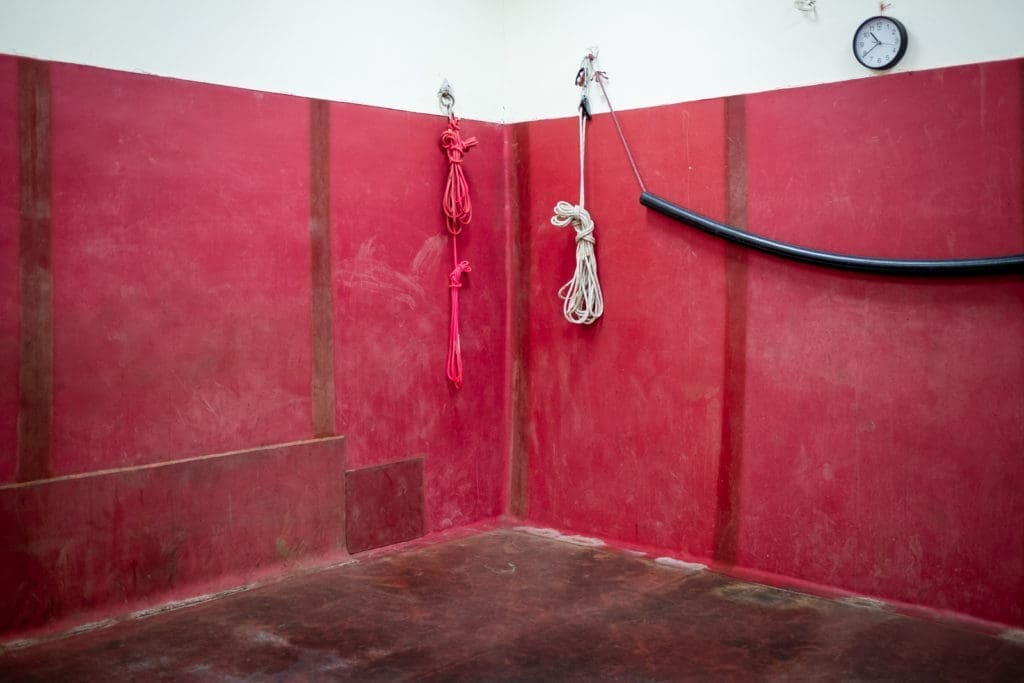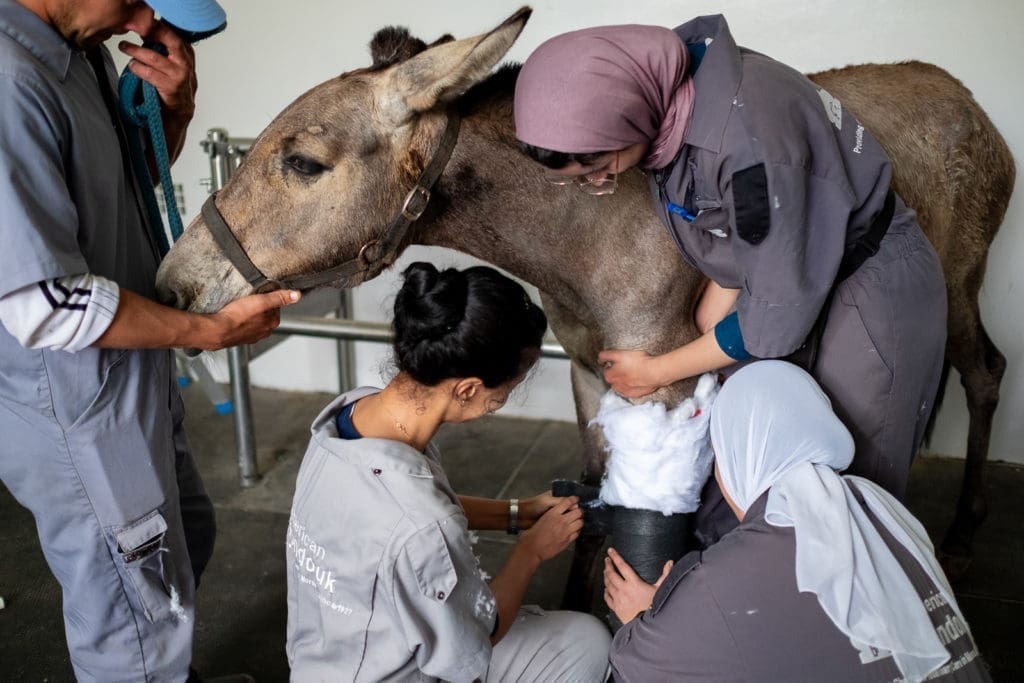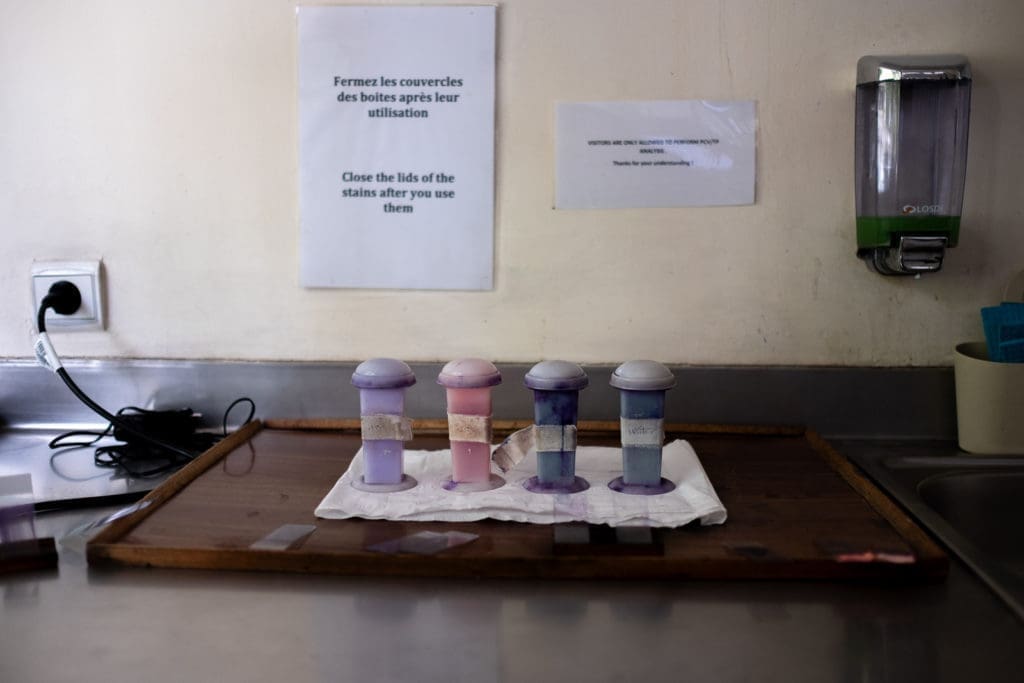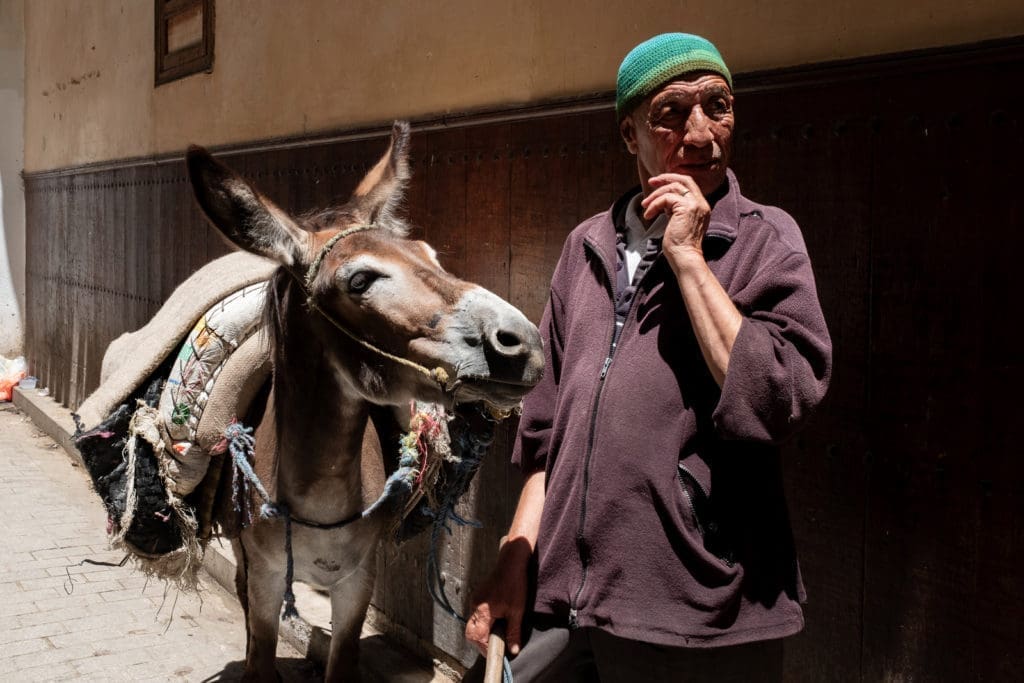It may seem paradoxical that a labyrinthine, chaotic, and crowded city like Fez (or Fès) has been, for me, a compass capable of taking me back exactly where I wanted to be: on the “threshold” of those who observe the world and its phenomena, being both a participant and an outsider in it, so much so that they can tell the story.
I have often gotten lost in search of places and, above all, those who live in the most authentic way possible. And I realized how, perhaps, right here in Fès, more than anywhere else I have visited so far, stereotypes manage to cage us into glossy realities that are not even close to the truth!
In the Old Medina of Fez
The first encounter with Fez was rather impactful. The taxi dropped me off in front of Bab Bou Jeloud (the blue gate), the main entrance to the Old Medina (Fes el-Bali), where, as it turned out, I had to venture on foot in search of my Riad. No problem, were it not that Fes el-Bali is an immense ‘pedestrian area’ spread over twelve kilometres, the largest and oldest in the Arab world, now a UNESCO heritage site. A veritable tangle of alleys – some 9400 – many of them dead-end and many not even mentioned on google maps. It seems almost impossible to think that anything else could exist outside when you are inside!
In the Old Medina, all motorised vehicles cannot enter. There wouldn’t be enough space between people, stalls of all kinds and the width of the streets, which are claustrophobic at times, where a mule can barely pass, let alone a car. The only means of transport in Fes el-Bali are donkeys, mules and hinnies. Their massive presence immediately catapults you into a city that, to the untrained eye, seems to have stopped in a time that no longer exists. ‘Balak, Balak’ (beware, beware) is a cry you soon get used to in the Medina. It announces their passage, always quick-footed and laden with whatever merchandise. This continuous hustle and bustle punctuates the times and pauses in the bargaining, forcing people to stop close to the walls or to seek an opening or refuge in the small shops to give way to them.
These animals represent a lifeline for the community. And they can almost be described as a luxury for those who own them. They are the engine of the fragile communications of Fes el-Bali. I believe time would flow again if they suddenly disappeared, and the Medina would lose its uniqueness. Even the many guides one encounters advise tourists to beware of mules, as they are the ‘masters of the city’.

Suffering in the eyes
The magic of the world’s largest car-free urban area vanishes when our gaze crosses that of ‘its masters’. They are suffering, tired, dirty and stressed, with loads far exceeding their height. There are trotting ones for transporting people, but mainly for moving goods: gas cylinders, rolls of carpet, paper, bricks, bread, fruit, and vegetables. There are ‘mule drivers’ with huge sacks for collecting rubbish. The ‘coke-mules’ are compressed under indescribable quantities of black bottles. The ‘bronze mules’ are used to transport metal objects. And then there are the ‘unrecognisable’ mules whose bodies cannot even be seen because of the immense amount of skinned skins covering them. In the long run, such weights on often undernourished animals inevitably damage their backs and limbs. Usually, the owners, out of ignorance or unaware of better practices, have rather brutal habits towards them. One is putting salt in their eyes or prodding them with sharp sticks to spur them on to quicken their pace. They also still use archaic bites that tear the palate and ill-fitting, painful slings. Due to their low incomes, the nutrition of these animals is also inadequate for the amount of effort they undergo every day. These donkeys feed on scraps or poor-quality feed. Often, one encounters donkeys eating rubbish, with the high risk of swallowing plastic or other waste that gets stuck in the gastrointestinal tract, sometimes causing even fatal colic. The truth is that since time immemorial, donkeys and mules, especially in the rural and poorer realities, have represented only and exclusively labour power, subsistence ‘tools’ that are not allowed to respect, to be sick, to slow down.
A free clinic for the donkeys and mules of Fez
The plight of these animals struck me today, just as it struck the soul of another woman some 100 years ago: Amy Bend Bishop. A young and wealthy American woman who, back in 1926, during one of her trips to Morocco, was deeply impressed by the miserable condition of the donkeys, mules and hinnies of Fez, often wounded and covered in sores and with no possibility of being cared for, given the poor conditions of their owners.
Back in America, Amy immediately took action to offer these noble and hard-working animals a better life, consisting mainly of proper care. And thanks to her generous start-up capital ($8000.00) and close acquaintances such as Dr Francis Rowley, at the time president of the Massachusetts Society for the Prevention of Cruelty to Animals (MSPCA) and Sydney Coleman, a prominent New York animal activist, she founded the American Fondouk in 1927. A shelter (fondouk) that has existed and survived for ninety-six years now and is unique: an equestrian clinic offering free care and services to the donkeys and mules of Fez. Even though almost one hundred years have passed since its inception and Morocco is a developing country, many of the population still live in extreme poverty. Veterinary care here is considered a luxury. And there is still too much closed-mindedness to look at these animals with a different eye. Yet it seems paradoxical when you think that the economic condition of these people is intimately linked to the health and well-being of their mules or donkeys.





The American Fondouk is supported by the president and entire board of the Boston MSPCA-Angell, loyal and generous donors, and all animal lovers. The clinic today is in the hands of director Ahmed Khairun, an equine surgeon, and his team, consisting of four veterinarians and twenty-three other people, including highly qualified Moroccan para veterinary staff, technicians and a farrier. In addition, veterinary students often spend two to four weeks here on internships to acquire practical skills. The clinic is open every day of the week. In the morning, examinations, checks and diagnoses are usually carried out. The afternoons are dedicated to medication and interventions.
A way to eradicate unawareness
The helpful director appeases my immense curiosity, accompanied by just as much amazement, by showing me the various rooms of the Fondouk. We move from the analysis laboratory to the diagnostic laboratory, from the X-ray to the masculine space, and finally to the operating room. A spacious red room with padded walls and floor to prevent injuries. He explains that the most prominent admissions are for lameness, often involving more than one limb, bone fractures, tendon injuries, and sprains due to excessive loads. Also standard are abdominal spasms and colic, caused by the rubbish they often ingest. Generally, if they can walk, equines arrive at Fondouk on their legs, accompanied by their owners. However, the facility provides an ambulance for more delicate cases to pick up and return.
Forty cubicles are available for inpatient stays, and all of them are occupied. One, in particular, attracts my attention because, unlike the others, it has its door closed. I look at Dr Khairun, who senses my perplexity and tells me: “I’ll open it in just a few seconds, OK?”. As the stable window slowly opens, I glimpse a miniature donkey with ears bandaged in yellow and blue to limit the noise as much as possible. Impassive, he does not turn around. A few moments later, the window closes again just as gently. The director explains that the poor animal is suffering from tetanus, the symptoms of which are often exacerbated by excitement or external stimuli, such as bright lights and loud noises. Tetanus is just one of the many viral or bacterial diseases that working animals struggle with due to the lack of vaccines. Owners not only have little money but, unfortunately, little awareness of prevention’s importance. ‘Treating a wound takes little time,’ Dr Khairun explains, ‘changing attitudes unfortunately takes generations. The real disease to eradicate is unawareness’. The Foundouk is also committed to this: it tries to educate and sensitise owners and non-owners alike to the care, feeding and maintenance of a healthy life for their working animal, on which the community of Fez depends.

Amidst the suffering brays and mangled, bandaged or intubated figures, I can only glimpse gentleness: tame, sometimes funny animals with long ears, heavy heads, big lips and deep, moist eyes. Their story does not lie in clichés but in the hunched backs of their bodies. The world suffers too much from indifference, and only this needs to be crippled. “Balak!

